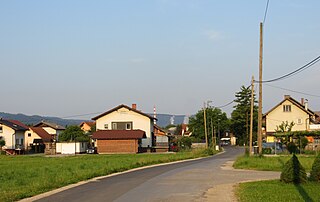
Ivančna Gorica is a settlement and a municipality in central Slovenia. It is part of the traditional region of Lower Carniola and is now included in the Central Slovenia Statistical Region.

Ravne v Bohinju is a settlement in the Municipality of Bohinj in the Upper Carniola region of Slovenia. It includes the hamlets of Spodnji Konec, Zgornji Konec, and Dolino.

Zalog pri Cerkljah is a village in the Municipality of Cerklje na Gorenjskem in the Upper Carniola region of Slovenia. It includes the hamlets of Zgornji Zalog, Srednji Zalog, Spodnji Zalog, Zgornja Trata, and Spodnja Trata.

Zavratec is a village in the hills east of Idrija in the traditional Littoral region of Slovenia. It includes the hamlets of Zgornji Zavratec and Spodnji Zavratec.

Bokrači is a village in the Municipality of Puconci in the Prekmurje region of Slovenia. It is divided into Spodnji Bokrači with the Fartel, Mlinar, Vukon, and Žagar farms, Zgornji Bokrači with the hamlets of Talaberov Breg and Žgonjarov Breg, and the hamlets of Duge Gomile and Malačičevi.

Veliki Boč is a dispersed settlement in the hills north of Selnica ob Dravi in northeastern Slovenia, right on the border with Austria.

Gornji Lenart is a settlement in the Municipality of Brežice in eastern Slovenia. The area was traditionally part of Styria. It is now included in the Lower Sava Statistical Region.

Cvišlerji is a settlement east of Kočevje in southern Slovenia. The area is part of the traditional region of Lower Carniola and is now included in the Southeast Slovenia Statistical Region. The settlement consists of the hamlets of Spodnji Cvišlerji, mostly containing newer houses built after the Second World War, and Zgornji Cvišlerji, containing older houses.

Podlesje is an abandoned settlement in the Municipality of Kočevje in southern Slovenia. It was a village inhabited by Gottschee Germans. During the Second World War its original population was expelled. The area is part of the traditional region of Lower Carniola and is now included in the Southeast Slovenia Statistical Region.

Mamolj is a settlement in the hills east of Litija in central Slovenia. Traditionally the area was part of Lower Carniola and is now included with the rest of the Municipality of Litija in the Central Sava Statistical Region. It includes the hamlets of Spodnji Mamolj, Zgornji Mamolj, Čebelnik, Češek, Podmilj, Resnarica, and Trinkavs.

Polšnik is a settlement in the Municipality of Litija in central Slovenia. Traditionally the area was part of Lower Carniola and is now included with the rest of the municipality in the Central Sava Statistical Region. Together with the two parts of the main settlement it also includes the hamlets of Na Puši, Seruč, Koprivnik, Slop, Glinjek, Velika Njiva, and Sušje.

Kolovrat is a settlement in the Municipality of Zagorje ob Savi in central Slovenia. The area is part of the traditional region of Upper Carniola. It is now included with the rest of the municipality in the Central Sava Statistical Region. The settlement includes the hamlets of Kal, Plavišnik, Prevalje, Spodnje Vrtače, Senčna Vas, and Strma Njiva.

Lapinje is a former village in the Municipality of Kočevje in southern Slovenia. The area is part of the traditional region of Lower Carniola and is now included in the Southeast Slovenia Statistical Region. Its territory is now part of the village of Podlesje.

Spodnji Pokštajn is a former village in the Municipality of Kočevje in southern Slovenia. The area is part of the traditional region of Lower Carniola and is now included in the Southeast Slovenia Statistical Region. Its territory is now part of the village of Podlesje.

Zgornji Pokštajn is a former village in the Municipality of Kočevje in southern Slovenia. The area is part of the traditional region of Lower Carniola and is now included in the Southeast Slovenia Statistical Region. Its territory is now part of the village of Podlesje.

Mokri Potok is a village in the Municipality of Kočevje in southern Slovenia. The area is part of the traditional region of Lower Carniola and is now included in the Southeast Slovenia Statistical Region. It no longer has any permanent residents.

Zgornji Kašelj is a formerly independent settlement in the eastern part of the capital Ljubljana in central Slovenia. It lies on a terrace above the left bank of the Ljubljanica River and extends west to Vevče and the source of Bajer Creek. It was part of the traditional region of Upper Carniola and is now included with the rest of the municipality in the Central Slovenia Statistical Region. The western part of the settlement was known as Dravlje, but this name passed out of use in the 20th century.

Spodnji Kašelj is a formerly independent settlement in the eastern part of the capital Ljubljana in central Slovenia. It is a compact settlement above the left bank of the Ljubljanica River between Zgornji Kašelj and Zalog. It was part of the traditional region of Upper Carniola and is now included with the rest of the municipality in the Central Slovenia Statistical Region.

Gradec is a former settlement in the Municipality of Litija in central Slovenia. It is now part of the town of Litija. Traditionally the area was part of Styria and is now included with the rest of the municipality in the Central Sava Statistical Region.
















